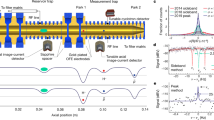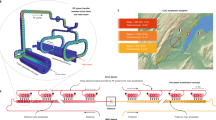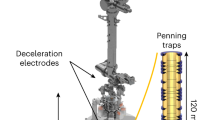Abstract
Charge conservation and the Pauli exclusion principle result from fundamental symmetries in the standard model of particle physics, and are typically taken as axiomatic. High-precision tests for small violations of these symmetries could point to new physics. Here we consider three models for violation of these processes, which would produce detectable ionization in the high-purity germanium detectors of the Majorana Demonstrator experiment. Using a 37.5 kg yr exposure, we report a lower limit on the electron mean lifetime, improving the previous best limit for the \(e\to {\nu }_{e}\overline{{\nu }_{e}}{\nu }_{e}\) decay channel by more than an order of magnitude. We also present searches for two types of violation of the Pauli exclusion principle, setting limits on the probability of an electron to be found in a symmetric quantum state.
This is a preview of subscription content, access via your institution
Access options
Access Nature and 54 other Nature Portfolio journals
Get Nature+, our best-value online-access subscription
$29.99 / 30 days
cancel any time
Subscribe to this journal
Receive 12 print issues and online access
$209.00 per year
only $17.42 per issue
Buy this article
- Purchase on Springer Link
- Instant access to full article PDF
Prices may be subject to local taxes which are calculated during checkout





Similar content being viewed by others
Data availability
Source data are provided with this paper.
Code availability
The analysis codes are available from the corresponding authors on reasonable request.
References
Wu, C. S., Ambler, E., Hayward, R. W., Hoppes, D. D. & Hudson, R. P. Experimental test of parity conservation in beta decay. Phys. Rev. 105, 1413–1415 (1957).
Freedman, S. & Clauser, J. Experimental test of local hidden-variable theories. Phys. Rev. Lett. 28, 938–941 (1972).
Aspect, A., Dalibard, J. & Roger, G. Experimental test of Bell’s inequalities using time-varying analyzers. Phys. Rev. Lett. 49, 1804–1807 (1982).
Bouwmeester, D. et al. Experimental quantum teleportation. Nature 390, 575–579 (1997).
Ignatiev, A. & Kuzmin, V. Search for slight violations of the Pauli principle. JETP Lett. 47, 6–8 (1987).
Greenberg, O. W. & Mohapatra, R. N. Local quantum field theory of possible violation of the Pauli principle. Phys. Rev. Lett. 59, 2507–2510 (1987).
Greenberg, O. Particles with small violations of Fermi or Bose statistics. Phys. Rev. D 43, 4111–4120 (1991).
Greenberg, O. Theories of violation of statistics. AIP Conf. Proc. 545, 113–127 (2000).
Bernabei, R. et al. New search for processes violating the Pauli exclusion principle in sodium and in iodine. Eur. Phys. J. C 62, 327–332 (2009).
Abgrall, N. et al. Search for Pauli exclusion principle violating atomic transitions and electron decay with a p-type point contact germanium detector. Eur. Phys. J. C 76, 619 (2016).
Okun, L. & Zeldovich, Y. Paradoxes of unstable electron. Phys. Lett. B 78, 597–600 (1978).
Mohapatra, R. Possible nonconservation of electric charge. Phys. Rev. Lett. 59, 1510–1512 (1987).
Aalseth, C. et al. Search for neutrinoless double-β decay in 76Ge with the Majorana Demonstrator. Phys. Rev. Lett. 120, 132502 (2018).
Arnquist, I. et al. Final result of the Majorana Demonstrator’s search for neutrinoless double-β decay in 76Ge. Phys. Rev. Lett. 130, 062501 (2023).
Abgrall, N. et al. New limits on bosonic dark matter, solar axions, Pauli exclusion principle violation, and electron decay from the Majorana Demonstrator. Phys. Rev. Lett. 118, 161801 (2017).
Arnquist, I. et al. Exotic dark matter search with the Majorana Demonstrator. Phys. Rev. Lett. 132, 041001 (2024).
Alvis, S. et al. First limit on the direct detection of lightly ionizing particles for electric charge as low as e/1000 with the Majorana Demonstrator. Phys. Rev. Lett. 120, 211804 (2018).
Alvis, S. et al. Search for trinucleon decay in the Majorana Demonstrator. Phys. Rev. D 99, 072004 (2019).
Arnquist, I. et al. Search for spontaneous radiation from wave function collapse in the Majorana Demonstrator. Phys. Rev. Lett. 129, 080401 (2022).
Workman, R. Particle Data Group. Prog. Theor. Exp. Phys. 2022, 083C01 (2022).
Belli, P. et al. New experimental limit on the electron stability and non-Paulian transitions in iodine atoms. Phys. Lett. B 460, 236–241 (1999).
Witten, E. Symmetry and emergence. Nat. Phys. 14, 116–119 (2018).
Chu, S. Gauge-invariant charge nonconserving processes and the solar neutrino puzzle. Mod. Phys. Lett. A 11, 2251–2257 (1996).
Ignatiev, A., Kuzmin, V. & Shaposhnikov, M. Is the electric charge conserved? Phys. Lett. B 84, 315–318 (1979).
Dubovsky, S., Rubakov, V. & Tinyakov, P. Is the electric charge conserved in brane world? J. High Energy Phys. 2000, 041 (2000).
Agostini, M. et al. Test of electric charge conservation with Borexino. Phys. Rev. Lett. 115, 231802 (2015).
Pauli, W. On the connexion between the completion of electron groups in an atom with the complex structure of spectra. Zeitschrift für Physik 31, 765–783 (1925).
Weinberg, S. Feynman rules for any spin. Phys. Rev. 133, B1318–B1332 (1964).
Suzuki, Y. et al. Study of invisible nucleon decay, n → ννν, and a forbidden nuclear transition in the Kamiokande detector. Phys. Lett. B 311, 357–361 (1993).
Bernabei, R. et al. Search for non-Paulian transitions in 23Na and 127I. Phys. Lett. B 408, 439–444 (1997).
Curceanu, C. et al. Test of the Pauli exclusion principle in the VIP-2 underground experiment. Entropy 19, 300 (2017).
Messiah, A. & Greenberg, O. Symmetrization postulate and its experimental foundation. Phys. Rev. 136, B248–B267 (1964).
Greenberg, O. & Mohapatra, R. Phenomenology of small violations of Fermi and Bose statistics. Phys. Rev. D 39, 2032–2038 (1989).
Akama, K., Terazawa, H. & Yasuè, M. Superficial violation of the Pauli principle due to the possible substructure of electrons. Phys. Rev. Lett. 68, 1826–1829 (1992).
Addazi, A. & Marcianò, A. A modern guide to θ-Poincaré. Int. J. Mod. Phys. A 35, 2042003 (2020).
Elliott, S., LaRoque, B., Gehman, V., Kidd, M. & Chen, M. An improved limit on Pauli-exclusion-principle forbidden atomic transitions. Found. Phys. 42, 1015–1030 (2012).
Piscicchia, K. et al. VIP-2—high-sensitivity tests on the Pauli exclusion principle for electrons. Entropy 22, 1195 (2020).
Napolitano, F. et al. Testing the Pauli exclusion principle with the VIP-2 experiment. Symmetry 14, 893 (2022).
Thoma, M. & Nolte, E. Limits on small violations of the Pauli exclusion principle in the primordial nucleosynthesis. Phys. Lett. B 291, 484–487 (1992).
Nolte, E. et al. Accelerator mass spectrometry for tests of the Pauli exclusion principle and for detection of beta beta decay products. J. Phys. G 17, S355–S362 (1991).
Bellini, G. et al. New experimental limits on the Pauli-forbidden transitions in 12C nuclei obtained with 485 days Borexino data. Phys. Rev. C 81, 034317 (2010).
Alvis, S. et al. Search for neutrinoless double-β decay in 76Ge with 26 kg-yr of exposure from the Majorana Demonstrator. Phys. Rev. C 100, 025501 (2019).
Arnquist, I. et al. Energy calibration of germanium detectors for the Majorana Demonstrator. J. Instrum. 18, P09023 (2023).
Abgrall, N. et al. LEGEND-1000 preconceptual design report. Preprint at https://arxiv.org/abs/2107.11462 (2021).
Abgrall, N. et al. The Majorana Demonstrator neutrinoless double-beta decay experiment. Adv. High Energy Phys. 2014, 365432 (2014).
Abgrall, N. et al. The Majorana Demonstrator radioassay program. Nucl. Instrum. Methods Phys. Res. A 828, 22–36 (2016).
Abgrall, N. et al. The Majorana Demonstrator calibration system. Nucl. Instrum. Methods Phys. Res. A 872, 16–22 (2017).
Wilks, S. The large-sample distribution of the likelihood ratio for testing composite hypotheses. Ann. Math. Stat. 9, 60–62 (1938).
Rolke, W., López, A. & Conrad, J. Limits and confidence intervals in the presence of nuisance parameters. Nucl. Instrum. Methods Phys. Res. A 551, 493–503 (2005).
James, F. Statistical Methods in Experimental Physics (World Scientific Publishing Company, 2006).
Wiseman, C. A low energy rare event search with the Majorana Demonstrator. J. Phys. Conf. Ser. 1468, 012040 (2020).
Dembinski, H. et al. scikit-hep/iminuit (v2.24.0). Zenodo https://doi.org/10.5281/zenodo.8249703 (2023).
Acknowledgements
This material is based upon work supported by the US Department of Energy, Office of Science, Office of Nuclear Physics under contract/award numbers DE-AC02-05CH11231, DE-AC05-00OR22725, DE-AC05-76RL0130, DE-FG02-97ER41020, DE-FG02-97ER41033, DE-FG02-97ER41041, DE-SC0012612, DE-SC0014445, DE-SC0018060, DE-SC0022339 and LANLEM77/LANLEM78. We acknowledge support from the Particle Astrophysics Program and Nuclear Physics Program of the National Science Foundation through grant numbers MRI-0923142, PHY-1003399, PHY-1102292, PHY-1206314, PHY-1614611, PHY-1812409, PHY-1812356, PHY-2111140 and PHY-2209530. We gratefully acknowledge the support of the Laboratory Directed Research & Development (LDRD) programme at Lawrence Berkeley National Laboratory for this work. We gratefully acknowledge the support of the US Department of Energy through the Los Alamos National Laboratory LDRD Program, the Oak Ridge National Laboratory LDRD Program and the Pacific Northwest National Laboratory LDRD Program for this work. We gratefully acknowledge the support of the South Dakota Board of Regents Competitive Research Grant. We acknowledge the support of the Natural Sciences and Engineering Research Council of Canada, funding reference number SAPIN-2017-00023, and from the Canada Foundation for Innovation John R. Evans Leaders Fund. We acknowledge support from the 2020/2021 L’Oréal-UNESCO for Women in Science Programme. This research used resources provided by the Oak Ridge Leadership Computing Facility at Oak Ridge National Laboratory and by the National Energy Research Scientific Computing Center, a US Department of Energy Office of Science User Facility. We thank our hosts and colleagues at the Sanford Underground Research Facility for their support.
Author information
Authors and Affiliations
Consortia
Contributions
All authors were involved in various aspects of detector construction, operation, maintenance, data acquisition, data-taking shifts, software development, data processing and analysis. C.W. and I.K. developed the low-energy data cleaning, and low-energy statistical analysis and spectrum fit techniques. J.M.L.-C. and C.W. conducted the high-energy spectral analysis and derived the limit on the Type I PEP-violating process. I.K. derived limits for the electron lifetime and Type III PEP-violating process. C.W. and I.K. wrote the paper. All authors reviewed, commented and approved the results and the final version of the paper.
Corresponding authors
Ethics declarations
Competing interests
The authors declare no competing interests.
Peer review
Peer review information
Nature Physics thanks Miriam Diamond, Ziqing Hong, Rabindra Mohapatra and Alessio Porcelli for their contribution to the peer review of this work.
Additional information
Publisher’s note Springer Nature remains neutral with regard to jurisdictional claims in published maps and institutional affiliations.
Extended data
Extended Data Fig. 1 Profiles of the likelihood function over the branching ratio B = β2/2, defined as the ratio of lifetimes between PEP-obeying and PEP-violating atomic transitions of electrons.
DEP: β2/2 ≤ 3.22e−04 (90% CL). SEP: β2/2 ≤ 9.99e−04 (90%). Combined: β2/2 ≤ 3.69e − 04 (90%). The profiles from the single-escape peak region (dotted) and the double-escape peak region (dot-dashed) are added and shifted to produce the combined curve (solid black). The upper limits are computed at the intersection Δχ2 = 2.71, representing the 90% confidence level. Vertical lines representing the 90% upper limits are added for reference.
Source data
Source Data Fig. 2
Histogram data points with brief description in header.
Source Data Fig. 3
Histogram data points with brief description in header.
Source Data Fig. 4
One file includes data for the top and bottom plots. Histogram data points with brief description in header.
Source Data Fig. 5
Histogram data points with brief description in header.
Rights and permissions
Springer Nature or its licensor (e.g. a society or other partner) holds exclusive rights to this article under a publishing agreement with the author(s) or other rightsholder(s); author self-archiving of the accepted manuscript version of this article is solely governed by the terms of such publishing agreement and applicable law.
About this article
Cite this article
The MAJORANA Collaboration. Search for charge non-conservation and Pauli exclusion principle violation with the Majorana Demonstrator. Nat. Phys. (2024). https://doi.org/10.1038/s41567-024-02437-9
Received:
Accepted:
Published:
DOI: https://doi.org/10.1038/s41567-024-02437-9
This article is cited by
-
Search for rule-breaking electrons
Nature Physics (2024)



